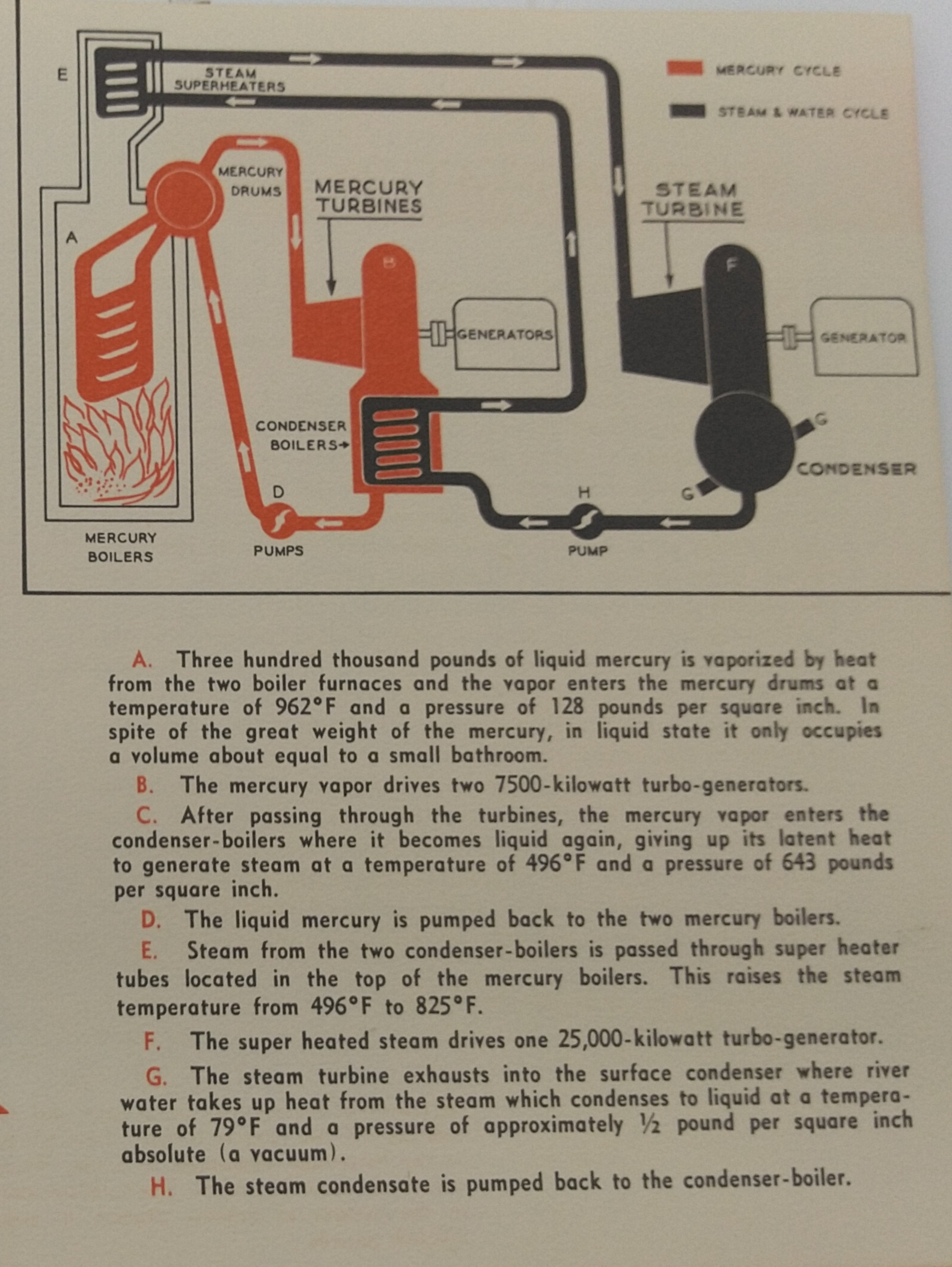mercury vapor turbine on:
[Wikipedia]
[Google]
[Amazon]
A mercury vapour turbine is a form of heat engine that uses mercury as the working fluid of its thermal cycle. A mercury vapour turbine has been used in conjunction with a steam turbine for generating electricity. This example of combined cycle generation was not widely adopted, because of high capital cost and the obvious toxic hazard if the mercury leaked into the environment.
The mercury cycle offers an efficiency increase compared to a steam-only cycle because energy can be injected into the
 The Electrical Year Book, 1937, contained the following description of a mercury vapour turbine operating in commercial use:
The Electrical Year Book, 1937, contained the following description of a mercury vapour turbine operating in commercial use:
Mercury as a Working Fluid
"Mercury Turbine Now A Success
drawing page 40
"Cheaper Power From Quicksilver"
''Popular Science Monthly'', September 1929 Thermodynamic cycles Power station technology
Rankine cycle
The Rankine cycle is an idealized thermodynamic cycle describing the process by which certain heat engines, such as steam turbines or reciprocating steam engines, allow mechanical work to be extracted from a fluid as it moves between a heat sourc ...
at higher temperature. Metallurgical developments have allowed steam-only plants to increase in efficiency over time, making the mercury vapour turbine obsolete. Modern combined cycle power plant
A combined cycle power plant is an assembly of heat engines that work in tandem from the same source of heat, converting it into mechanical energy. On land, when used to make electricity the most common type is called a combined cycle gas turb ...
generating stations operate at 61% efficiency, and with none of the safety issues inherent to a binary mercury Rankine cycle steam power plant.
Historical example
 The Electrical Year Book, 1937, contained the following description of a mercury vapour turbine operating in commercial use:
The Electrical Year Book, 1937, contained the following description of a mercury vapour turbine operating in commercial use:
The advantage of operating a mercury-vapour turbine in conjunction with a steam power plant lies in the fact that the complete cycle can be worked over a very wide range of temperature without employing any abnormal pressure. The exhaust from the mercury turbine is used to raise steam for the steam turbine. The Hartford Electric Light Co. (U.S.A.) has a 10,000kW turbo-generator driven by mercury vapour, which reaches the turbine at 70 lb. per sq. in. (gauge), 880°F. The mercury vapour is condensed at 445°F and raises 129,000 lb. steam per hr. at 280 lb. per sq. in. pressure. The latter is superheated to 735°F and passed to the steam turbines. During 4 months continuous operation, this plant averaged about 0.715 lb. of coal per kWh of net output, about 43% of the output being from the mercury turbine generator and 57% from the steam plant. On maintained full-load the heat output averages 9800 BTU per net kWh 4.8% efficiency It is believed that maintenance costs will be lower than in ordinary steam plant. The back-pressure on the mercury turbine is fixed by the steam boiler pressure; only a small vacuum pump is needed, as there is no air or other gas in the mercury system.Power plants designed by
William Le Roy Emmet
William Le Roy Emmet (July 10, 1859 – September 26, 1941) was an electrical engineer who made major contributions to alternating current power systems including the design of large rotary converters.
Biography
Emmet was born in New Rochelle ...
were constructed by General Electric
General Electric Company (GE) is an American multinational conglomerate founded in 1892, and incorporated in New York state and headquartered in Boston. The company operated in sectors including healthcare, aviation, power, renewable en ...
and operated between 1923 and 1950. Large plants included:
* Hartford, Connecticut, 1.8 MW, starting in 1922, uprated in stages to 15 MW in 1949
* Kearny Generating Station
Kearny Generating Station is a peaking power plant on the banks of the Riverbend of the Hackensack River in South Kearny, New Jersey. Owned and operated by Public Service Electric and Gas Company (PSEG) the power station consists of 10 simple ...
, New Jersey, 20 MW mercury turbine +30 MW steam, started 1933
* Schenectady, New York
* Portsmouth, New Hampshire, 40 MW, 1950 Nag ''Power Plant Engineering 3e'', Tata McGraw-Hill Education, 2008 page 107 Herman Branover, Yeshajahu Unger ''Metallurgical Technologies, Energy Conversion, and Magnetohydrodynamic Flows''AIAA, 1993 page 337-338
References
{{reflistExternal links
Mercury as a Working Fluid
"Mercury Turbine Now A Success
drawing page 40
"Cheaper Power From Quicksilver"
''Popular Science Monthly'', September 1929 Thermodynamic cycles Power station technology